Excerpts from Jim Conrad's
Naturalist Newsletter

from the May 29, 2011 Newsletter issued from Mayan Beach Garden Inn 20 kms north of Mahahual; Caribbean coastal beach and mangroves, ~N18.89°, ~W87.64°, Quintana Roo state, MÉXICO
GULLFEED
During a garbage-picking-up hike up the beach Marcia walked over to a handsome, flowering and fruiting, woody shrub with succulent leaves and asked what it was. Nearly always if I have flowers and fruits I can recognize the family a plant belongs to, and often the genus, but I didn't have the slightest idea who this one was. You can see Marcia conferring with the plant above.
A close-up of the plant's leaves and black, half-inch wide (1.3cm) drupes, which are topped by scars where the corolla fell off the flower's inferior ovary, is below:

A white flower a little less than an inch long (22mm) oddly split along the top and with its thick, stiff style arcing from the split above the corolla is shown below:

The style also is curious because of the two-lobed, flattish stigma tipping it -- the stigma being the female part where male pollen is supposed to land, germinate, and send the male sex germ down to the ovary in the bottom of the flower. Notice the fuzzy area below the yellow stigma. That fuzzy zone, known as the "pollen cup," or indusium, concentrates pollen, assuring pollination.
The reason this common shrub stumped me is that it belongs to a plant family I've never been introduced to, and seldom even heard of, the Goodenia Family, the Goodeniaceae, a family of some twelve genera and over 400 species, occurring mostly in Australia. One of the twelve genera is "pantropical" -- found throughout the world's tropics -- and that's what we have here. Our seaside bush is SCAEVOLA PLUMIERI. Since it's also found coastally in Florida, Louisiana and Texas, it has English names, including Gullfeed, Beachberry and Inkberry.
I identified the bush by recognizing the flower's similarity to lobelia blossoms, then by checking unrecognized plants listed for this area in plant families closely related to the lobelias. On the Evolutionary Tree of Life, Goodeniaceae does occupy a branch near the lobelieas, but it's even closer to the Composite Family, with its sunflowers, goldenrods and asters.
What a pleasure to meet something completely new to me like this, to see novel new ways of doing things -- to experience yet another "variation on the theme" of the "average wildflower" carried in my head.